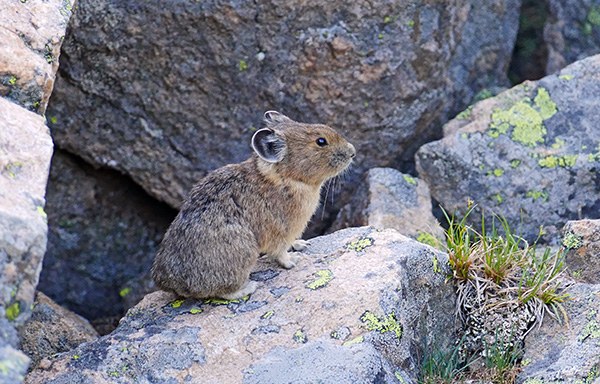
Written by Derek Stinson and Alex Biswas.
Pikas, those fuzzy rabbit relatives calling from rocky talus, have received attention in recent years due to the looming threat of climate change. They are generally found at high elevations, and with shrinking alpine zones becoming ever more common, their resilience on a warming planet is something many are questioning.
Pika behavior and potential habitat loss
Pikas eat a variety of plants, including grasses, ferns, wildflowers, and more. Unlike many mountain critters, they don’t hibernate. Instead, they gather hay piles that they feed on throughout the winter. Pikas use snow to insulate themselves in winter, and can freeze if there’s little or no snowpack. Some populations in smaller, relatively low elevation sites across Nevada, Idaho, and southeastern Oregon have disappeared, and populations in southern Nevada went extinct in the prehistoric era during the post-glacial warming. A 2007 petition to list the pika under the U.S. Endangered Species Act was based on these population extinctions in the Great Basin, the pika’s microclimate needs, and predictions of future climate scenarios. Subsequent surveys of over 3,000 sites found that pikas were present at most of them, and they appeared to be secure in the core of their range. Based on these studies, the U.S. Fish and Wildlife Service determined in 2010 that the status of pikas did not warrant listing them under the Endangered Species Act at that time. However, recent studies suggest that their future may now depend on international action to survive the growing threats posed by climate change.
Unanswered questions
We still have a lot to learn about these little ball-shaped creatures, in particular where they could live and thrive when faced with a warming climate. Pikas are found at some surprisingly low elevations in western Washington, Oregon, and British Columbia, and we’re not sure why they live in places where they get little or no snow cover and don’t create their typical hay piles for the winter. They have also been found in human-created talus such as roadcuts and quarries in western Washington and Oregon. The cool, moist conditions west of the Cascade Crest may enable pikas to forage year-round and augment their diet with moss. These conditions make travel easier between sites, which has likely aided their colonization of human-created rock piles.
Many questions arise from these adaptive behaviors. Will populations at the lower, rainy “west-side” sites prove to be more secure in the long run than those in high-elevation sites that may eventually receive less snow? Are low-elevation pika sites lost when the rock is used for road-building? And are pikas still present in Washington locations reported 10 or 20 years ago? To help complete the picture, we are asking recreationists to record their observations of pikas in Washington.
RECORD YOUR PIKA OBSERVATIONS
The Washington Department of Fish and Wildlife has created a tool for you to record your pika observations. All observations are welcome, but we are particularly interested in those from low elevation sites (<2,000 ft), very high elevation sites (above the timberline), man-made habitats, or less-traveled trails. If you can, we ask that you include a photo or an audio recording to upload. In our Pika Observation Survey instructions, we’ve also included resources to help you make sure what you observe is a pika: a tail-less, eared, fuzzy, baked potato-sized critter.
Download the ArcGIS Survey 123 app to submit your observations. The survey and instructions can be found at https://wdfw.wa.gov/species-habitats/species/ochotona-princepshttps://wdfw.wa.gov/species-habitats/species/ochotona-princeps.
This article originally appeared in our Spring 2022 issue of Mountaineer Magazine. To view the original article in magazine form and read more stories from our publication, visit our magazine archive.
 Derek Stinson
Derek Stinson